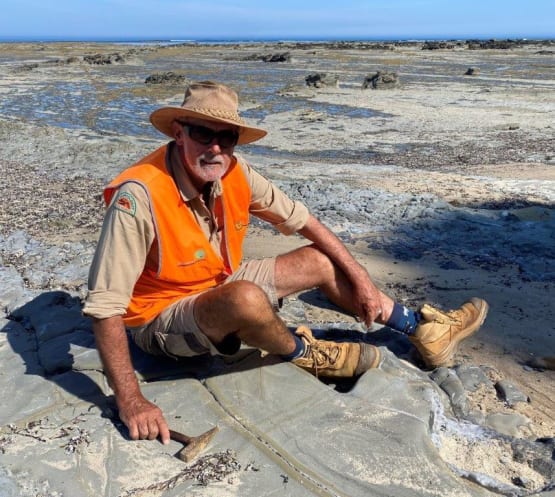IT’S not everyone interested in looking for fossilised bones that gets their own dinosaur named after them.
But Phillip Island palaeontologist Mike Cleeland and Wonthaggi compatriot, Lesley Kool OAM, are members of that very exclusive club after discovering a car-sized amphibian, Koolasuchus Cleelandi, a 125 million year old beast that looks something like a cross between a newt and a crocodile.
The pair made the discovery between San Remo and Inverloch in 1997 with Koolasuchus Cleelandi since raised to the status of Victoria’s fossil emblem.
Now Mike Cleeland has done it again with a discovery he made at Shack Bay near Inverloch, as a member of the volunteer organisation with exclusive rights to look for fossils on the Bass Coast, Professor Patricia Vickers-Rich’s ‘Dinosaur Dreaming’ group, back in 2007.
But it’s only been in recent days, on November 2, with the publication of a research paper, in ‘Cretaceous Research’ by Monash University PhD candidate and palaeontologist Jake Kotevski, that the full impact of the discovery has been revealed.
“It’s the first time that a skull fragment from a meat-eating dinosaur has been found in Australia and it’s also the oldest member of the Megaraptorid family found anywhere in the world,” said an ecstatic Mike Cleeland this week.
“It’s significant because it means that these creatures might have evolved here, in Australia, and ultimately moved north, not the other way around.”
Mike said that when he found the fossil, there had been some thoughts that it might be significant, but it took time, 16 years in fact, to decide how significant.
Here’s what lead author of the research paper, Jake Kotevski, had to say in his conclusion about the significance of the piece of Megaraptorid skull found by Mike Cleeland:
“The frontal and fused parietal fragment described herein (item number P229038) constitutes the first non-mandibular cranial element from a non-avian theropod to be reported from Australia.
“This frontal represents the geologically oldest megaraptorid skull element worldwide, and emphasises the prevalence of this theropod group in the mid-Cretaceous of Australia.”
He said various forms of analysis were used to place the specimen in the Megaraptoridae group of dinosaurs.
However, Mr Kotevski said additional remains will be required to further establish what sort of dinosaur it is and “the interrelationships within Megaraptora”.
He goes on to say that the megaraptorids found in what’s known as the ‘Wonthaggi Formation’ are the oldest worldwide, with this fossilised skull fragment indicating some unique characteristics of the local species, providing “some support in favour of the hypothesis that Megaraptoridae had an Australian origin”.
This is huge, according to Mike, but there’s still a way to go.
“It’s a significant discovery but what they are saying is that they need to find more bones so they can say for sure if it is a different species.
“My understanding of it is Jake hasn’t been able to link it with other fragments found in this area or elsewhere, and they are going to need to find a lot more to say for sure.”
Professor Pat Rich said it would also take time, and many more fossil finds, before we can say for sure if these types of dinosaurs originated here and spread to the northern hemisphere, rather than the other way around.
“They have a much bigger catalogue than us. We’ve barely touched the surface. We’ll need a lot more evidence before we can be sure about making claims like that,” Professor Rich said.
And her ‘Dinosaur Dreaming’ group will be doing just that in February next year when they have a major fossil-finding project planned for an area near Eagles Nest.
But Mrs Rich did say that this type of dinosaur would have been a highly evolved killing machine, and lucky for us, it pre-dated humans by more than 120 million years!
According to Jake Kotevski the cranial fragment found by Mike Cleeland indicates a megaraptorid-type dinosaur of between 3m and 4m high.
“It's very hard to say off one bone, but a relative from South America has the same bone, is more complete, is of a similar size and is roughly 3m.”
He also acknowledged that the meat eating (theropod) dinosaurs from Victoria, which are the subject of his PhD, are “undersampled” with only five fossils in all recovered from the Shack Bay area, although Megaraptorids are known to be present in many other localities across the state.
The nearly complete frontal and fused parietal fragment found at Shack Bay by Mike Cleeland was prepared by David Pickering using specialist equipment and now resides in the Palaeontology Collection of Museums Victoria in Melbourne.
The South Gippsland Conservation Society, the Bunurong Environment Centre and Mike Cleeland conduct regular dinosaur discovery tours during the school holidays. Watch out for upcoming dates: https://sgcs.org.au/







